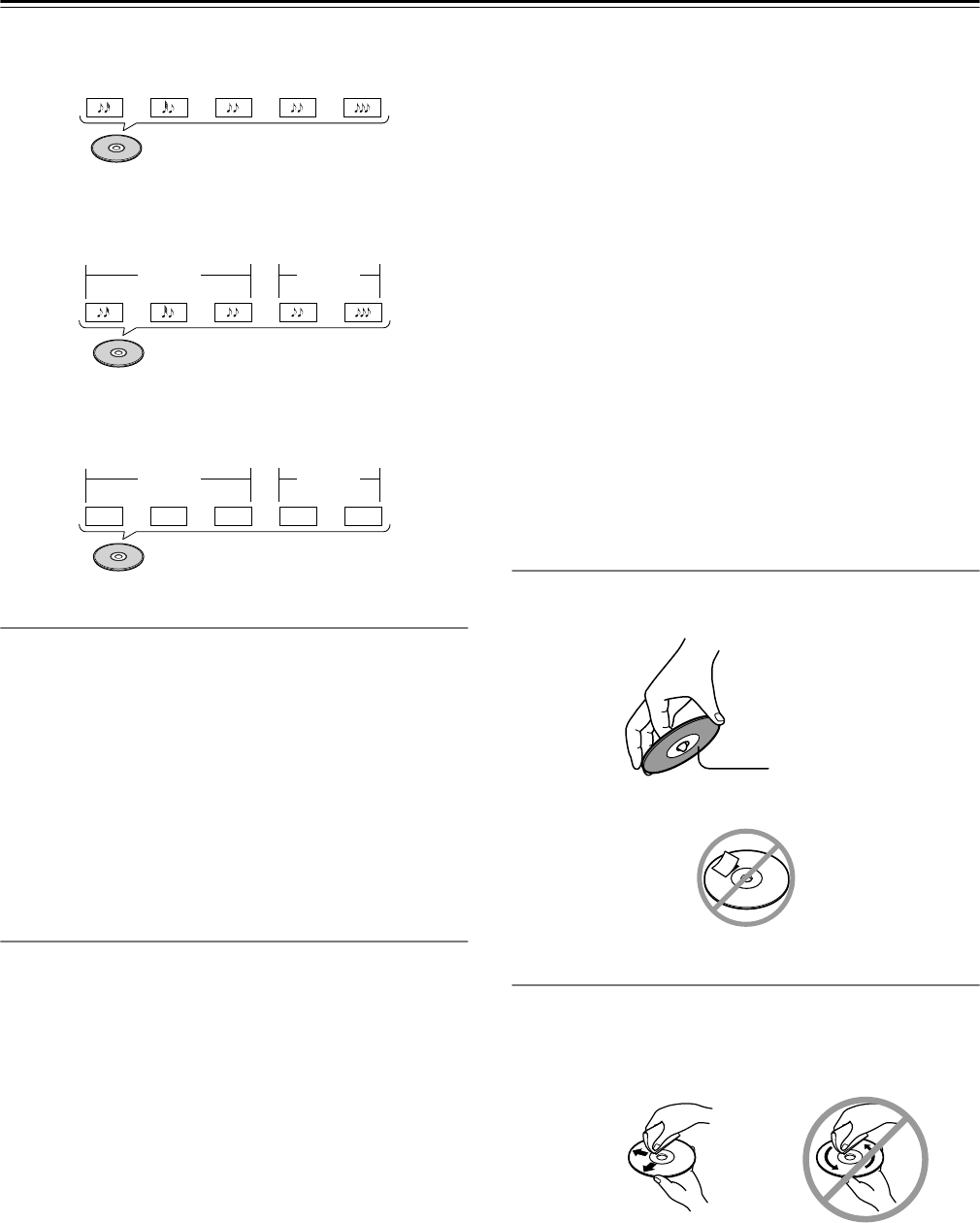
8
Introduction—Continued
■ Audio CD Format
Audio CDs contain tracks.
■ MP3/WMA Files
MP3 and WMA files are typically organized into folders. The
DV-CP702 handles MP3 and WMA files as tracks.
■ JPEG Files
JPEG picture files are typically organized into folders. The DV-
CP702 handles JPEG files as tracks.
Video CDs
The DV-CP702 supports Version 1.1 and Version 2.0 of the
Video CD standard. Version 2.0 supports PBC (Playback Con-
trol).
•
Video CD (Version 1.1)
The contents of Video CDs that conform to Version 1.1 of the
Video CD standard are played as tracks.
•
Video CD with PBC (Version 2.0)
In addition to the functions supported by Version 1.1, Version
2.0 offers playback control via interactive menus and search
functions. Note that the DV-CP702 doesn’t support all Video
CD PBC functions.
MP3/WMA/JPEG Compatibility
• The DV-CP702 can play/display MP3, WMA, and JPEG files
recorded on CD-R and CD-RW discs.
• Discs must be in ISO9660 Level 2 format (folders can be up
to eight levels deep).
• Discs must be finalized.
• The DV-CP702 can only recognize the first session on multi-
session discs.
• You can determine the order in which the DV-CP702 plays/
displays your MP3/WMA songs and JPEG pictures by prefix-
ing file and folder names with a three-digit number. For exam-
ple 001.Root, 002.Folder, and so on, and 001.Track.mp3,
002.Track.mp3, and so on.
• Only the first eight characters of folder and track names
(excluding the filename extension) are displayed.
• The folder numbered “001” appears as “ROOT” in the Disc
Navigator.
• The DV-CP702 supports up to 999 folders and up to 672 files
per folder.
• If you try to play an incompatible file, the message “This for-
mat cannot be played” appears on the display.
■ MP3
• MP3 files must be MPEG1 Audio Layer 3 format, 44.1 or
48 kHz, fixed bit-rate.
• MP3 files must have a “.mp3” or “.MP3” filename extension.
• Variable bit-rates (VBR) from 64 kbps to 384 kbps are sup-
ported. (Playing times may display incorrectly with VBR.)
■ WMA
• WMA files must have the copyright option turned off.
• Sampling rates 44.1/48 kHz are supported.
• Variable bit-rates (VBR) from 16 kbps to 192 kbps are sup-
ported. (Playing times may display incorrectly with VBR.)
• WMA files must have a “.wma” or “.WMA” or “.ASF” file-
name extension.
■ JPEG
• JPEG files must have a “.jpg” or “.JPG” or “.JPEG” filename
extension.
• Baseline JPEG files are supported. Progressive JPEG files are
not.
• Only JPEG files with the following brightness/color differ-
ence ratios are supported: 4:4:4, 4:2:2, and 4:1:1.
• JPEG files must be less than 5 megabytes in size.
Handling Discs
• Never touch the underside of a disc. Always hold discs by the
edge, as shown.
• Never attach adhesive tape or sticky labels to discs.
Cleaning Discs
• For best results, keep your discs clean. Fingerprints and dust
can affect the sound and picture quality and should be
removed as follows. Using a clean soft cloth, wipe from the
center outwards, as shown. Never wipe in a circular direction.
• To remove stubborn dust or dirt, wipe the disc with a damp
soft cloth, and then dry it with a dry cloth.
• Never use solvent-based cleaning fluids, such as thinner or
benzine, commercially available cleaners, or antistatic sprays
intended for vinyl records, because they may damage the disc.
Audio CD
Track 2 Track 4Track 3Track 1 Track 5
Track 2
Track 3
Track 1
Track 2Track 1
Folder 1 Folder 2
MP3/WMA (CD-R/CD-RW)
Track 2
Track 3
Track 1
Track 2Track 1
Folder 1 Folder 2
JPEG (CD-R/CD-RW)
Underside
✔


















